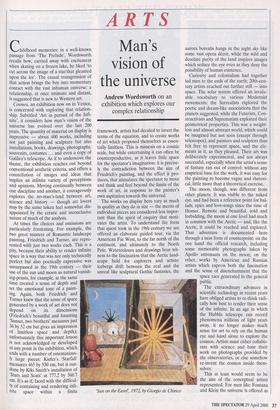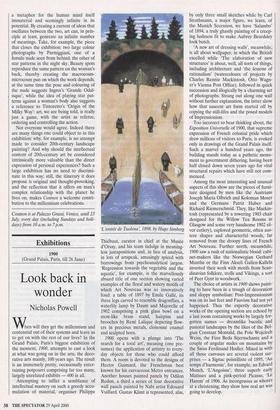ARTS
Man's vision of the universe
Andrew Wordsworth on an exhibition which explores our complex relationship Childhood memories: in a well-known passage from 'The Prelude', Wordsworth recalls how, carried away with excitement when skating on a frozen lake, he liked 'to cut across the image of a star/that gleamed upon the ice'. The casual transgression of that action brings the boy into momentary contact with the vast inhuman universe: a relationship, at once intimate and distant, is suggested that is new to Western art. Cosmos, an exhibition now on in Venice, is concerned with exploring that relation- ship. Subtitled 'Art in pursuit of the Infi- nite', it considers how man's vision of the universe has evolved over the last 200 years. The quantity of material on display is impressive — about 400 works, including not just painting and sculpture but also installations, books, drawings, photographs, souvenirs, costumes ... and even a copy of Galileo's telescope. As if to underscore the theme, the exhibition reaches out beyond conventional aesthetic criteria, and offers a constellation of images and ideas that implies an infinite variety of perceptions and opinions. Moving continually between one discipline and another, it courageously explores the no-man's-land between art, science and history — though art lovers may by the same token feel somewhat dis- appointed by the erratic and inconclusive nature of much of the analysis.
At times the choices and omissions are particularly frustrating. For example, the two great masters of Romantic landscape painting, Friedrich and Turner, are repre- sented with just two works each. This is a pity, because their ability to render infinite space in a way that was not only technically perfect but also poetically expressive was unsurpassed in the 19th century — their use of the sun and moon as natural vanish- mg-points, for example, at the same time created a sense of depth and set the emotional tone of a paint- ing. Again, both Friedrich and Turner knew that the sense of space generated by a work of art does not depend on its dimensions (Friedrich's beautiful and haunting 'Sunset, two brothers' measures just 36 by 52 cm but gives an impression of limitless space and depth); Unfortunately this important lesson is not acknowledged or developed at any point in the exhibition, which ends with a number of ostentatious- ly large pieces: Kiefer's `Starfall' measures 465 by 530 cm, but is out- done by Kiki Smith's installation of 'Stars and Scats' at 777.2 by 360.7 cm. It's as if, faced with the difficul- ty of containing and rendering infi- nite space within a finite framework, artists had decided to invert the terms of the equation, and to create works of art which proposed themselves as essen- tially limitless. This is mimesis on a cosmic scale, but while entertaining it can often be counterproductive, as it leaves little space for the spectator's imagination: it is precise- ly the contradiction between the size of Friedrich's painting, and the effect it pro- duces, that stimulates the spectator to move and think and feel beyond the limits of the work of art, in response to the painter's own aspiration towards the universal.
The works on display here vary as much in quality as they do in size — the merits of individual pieces are considered less impor- tant than the spirit of enquiry that moti- vates the artist. To understand the form that quest took in the 19th century we are offered an elaborate guided tour, via the American Far West, to the far north of the continent, and ultimately to the North Pole. Watercolours and drawings bear wit- ness to the fascination that the Arctic land- scape held for explorers and artists: icebergs drift between the real and the unreal like sculptural Gothic fantasies, the 'Sun on the Easel', 1972, by Giorgio de Chirico aurora borealis hangs in the night sky like some vast opera decor, while the wild and desolate purity of the land inspires images which seduce the eye even as they deny the possibility of human existence.
Curiosity and colonialism had together led men to the ends of the earth; 20th-cen- tury artists reached out further still — into space. The solar system offered an invalu- able vocabulary to various Modernist movements: the Surrealists explored the poetic and dream-like associations that the planets suggested, while the Futurists, Con- structivists and Suprematists exploited their geometrical properties. This was a weight- less and almost abstract world, which could be imagined but not seen (except through telescopes), and painters and sculptors thus felt free to represent space, and the ele- ments in it, as they pleased. Their art was deliberately experimental, and not always successful, especially when the artist's sense of fantasy ran out of control: without any empirical base for the work, it was easy for the painting to become vague and rhetori- cal, little more than a theoretical exercise.
The moon, though, was different from other planets. It was visible to the naked eye, and had been a reference point for bal- lads, epics and love-songs since the time of Homer. Remote and beautiful, cold and forbidding, the moon at one level had much in common with the Arctic — and, like the Arctic, it could be reached and explored. That adventure is documented here through a neat form of counterpoint: on the one hand the official research, including some memorable photographs taken by Apollo astronauts on the moon; on the other, works by American and Russian artists which express both the fascination and the sense of disenchantment that the space race generated in the general public.
The extraordinary advances in scientific technology in recent years have obliged artists to re-think radi- cally how best to render their sense of the infinite. In an age in which the Hubble telescope can record phenomena millions of light years away, it no longer makes much sense for art to rely on the human eye and hand alone to explore the cosmos. Artists must either collabo- rate with science and base their work on photographs provided by the observatories, or else somehow re-invent the cosmos inside them- selves.
This at least would seem to be the aim of the conceptual artists represented. For men like Fontana and Klein the universe is offered as a metaphor for the human mind itself immaterial and seemingly infinite in its potential. By creating a current of ideas that oscillates between the two, art can, in prin- ciple at least, generate an infinite number of meanings. Take, for example, the piece that closes the exhibition: two large colour photographs by Parmiggiani, one of a female nude seen from behind, the other of star patterns in the night sky. Beauty spots reproduce the same pattern on the woman's back, thereby creating the macrocosm- microcosm pun on which the work depends; at the same time the pose and colouring of the nude suggests Ingres's 'Grande Odal- isque', while the idea of playing star pat- terns against a woman's body also suggests a reference to Tintoretto's 'Origin of the Milky Way': art, we are being told, is really just a game, with the artist as referee, ordering and controlling the action.
Not everyone would agree. Indeed there are many things one could object to in this exhibition: why, for example, is no attempt made to consider 20th-century landscape painting? And why should the intellectual content of 20th-century art be considered intrinsically more valuable than the direct expression of personal experiences? Such a large exhibition has no need to discrimi- nate in this way; still, the itinerary it does propose is original and thought-provoking, and the reflection that it offers on man's complex relationship with the planet he lives on, makes Cosmos a welcome contri- bution to the millennium celebrations.
Cosmos is at Palazzo Grassi, Venice, until 23 July, every day (including Sundays and holi- days) from 10 a.m. to 7 p.m.



























































 Previous page
Previous page